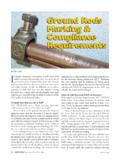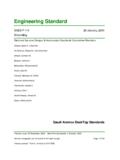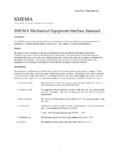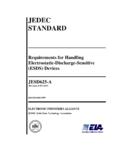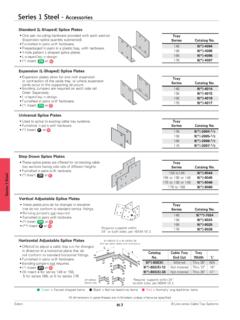Transcription of Ground Rod And Coupling Specification
1 Galvan Industries, Inc. Ground Rod And Coupling Specification For Copper-Coated, Hot-Dip Galvanized And Stainless-Steel Ground Rod Electrodes NORMATIVE REFERENCES. American National Standards Institute ANSI 1988 (expired 1993, under review to be updated by IEEE). Zinc-Coated Ferrous Ground Rod Electrodes for Overhead or Underground Lines American Society for Testing and Materials ASTM A-108. Standard Specification for Steel Bars, Carbon, Cold-Rolled ASTM A-123. Standard Specification for Zinc Coatings of Iron and Steel Products ASTM A-370. Standard Test Methods and Definitions for Mechanical Testing of Steel Products ASTM E-376-96. Standard Practice for Measuring Coating Thickness by Magnetic-Field or Eddy- Current Test Methods ASTM A510. Standard Specification for General Requirements for Wire Rods and Coarse Round Wire, Carbon Steel ASTM 571-97E1. Standard Practice for Qualitative Testing of Metallic Coatings Canadian Standards Association CSA No.
2 41-M1987; Grounding and Bonding Equipment Canena THC-99 Standard (anticipated introduction late 2006). Underwriters Laboratories ANSI/UL467-1993; Standard for Grounding & Bonding Mexican Electrical Code NMX-J-567; Bonding & Grounding Canadian Electrical Code No. 41; Bonding & Grounding Technical Engineering Service Sharp Edge Tester SET-59. Ground Rods Copper-Coated & Hot-Dip Galvanized Material: The steel used in the production of the Ground rod core shall meet the requirements of ASTM-A370, and shall have a minimum tensile strength of 80,000. PSI and a minimum Rockwell B hardness of 80. The rod steel core shall be cold- drawn to assure enhanced hardness and straightness. Length: Rod length tolerances shall be 0, + 5/8 inch for each size specified. Finished Diameters: Rod diameters (inches nominal) shall fall within the ranges listed below. Finished Diameter Finished Diameter Nominal Threadless or Threaded Threadless Diameter Copper-Coated Zinc-Coated 5/8 5/8 (RUS) 1 Coating: The coating thickness for copper-coated rods shall not be less than inch thick at any point on the rod when measured with an eddy-current device per ASTM E- 376.
3 The coating thickness for RUS copper-coated rods shall not be less than inch thick at any point on the rod when measured with an eddy-current device per ASTM E-376. The coating thickness for zinc-coated rods shall not be less than inch thick at any point on the rod when measured in accordance with ASTM E-376. Zinc coated rods shall be hot-dip galvanized in accordance with ASTM A-123. Threads: Threads on rods on copper-coated sectional rods shall be of the roll- thread type, and shall conform on each end of the rod electrode per the following: Nominal Thread A UNC Thread B . Diameter Length 1/16, + 1/8 Profile 1 1/16 9/16-12. 5/8 1 3/16 5/8-11. 1 -10. 1 1 11/16 1-8. A A. B B. Rod ends: The configuration of the chamfer and drive end of each rod shall conform to the following: A B. 60 60 . Nominal Point End Chamfer End Diameter A B . 3/16 3/32. 5/8 3/16 1/8. 1/8. 1 3/8 7/32. Adhesion Test: An 18-inch length of the rod with one end cut to a 45 degree point shall be driven between two steel clamping plates, or the jaws of a vise set inch less than the diameter of the rod, so as to shear off sufficient metal to expose the bond between the jacket and rod.
4 Peeling of the jacket by the steel plates or the jaws of the vise is acceptable, but there shall be no other evidence of separation of the jacket from the steel core. Bend Test: There shall be no evidence of cracking of the jacket if at room temperature a length of the rod is rigidly held in a clamp or vise and the free end bent by applying a force normal to the rod at a distance from the clamping device equal to 40 times the rod diameter. The magnitude of the force and the direction of application shall be such that the rod is permanently bent through a 30-degree angle without failure of the copper coating. Surface Evaluation: The surface of the Ground rod, including point and chamfer ends, shall be smooth and uniform, and free from blisters, pitting, slivers, peeling, flaking and other types of sharp projections as safety criteria. Conformance to no sharp projections shall be tested using a Technical Engineering Service Company, Sharp Edge Tester, Model SET-50 device.
5 There shall also be no evidence of cracking of the coating. Straightness: All Ground rod electrodes shall be straight per the following test and acceptance criteria. A Ground rod sample shall be supported by two V blocks with a dial feeler gage located at the mid-point of the V blocks per the following figure. While rotating the Ground rod by hand, the maximum and minimum readings shall be recorded. The readings are to be subtracted for the total deviation. The average deviation from straight for the length of the Ground rod located between the V blocks is determined by the following formula: Average Deviation = Maximum Deviation less Minimum Deviation 2 x 3 feet The straightness of the rod, per this calculation, shall not vary more than inch per foot. Marking: The Ground rod shall be permanently and legibly marked with the manufacturer's identification, and the catalog or equivalent designation, within the top 6 inches of the drive, or chamfer, end of the Ground rod.
6 In addition, a rod end shall be color-coded to identify diameter per the following: Copper-Coated: Nominal Threadless or Diameter Threaded Green 5/8 Copper 5/8 (RUS) Yellow Black 1 N/A. Hot-Dip Galvanized: Nominal Diameter Threadless Green 5/8 Copper 5/8 (RUS) N/A (fully galvanized). Black 1 N/A. Packaging: Rods shall be packaged in sub-bundles of five (5) rods, and master bundles shall be secured with metal banding. Master bundles shall consist of twenty (20) sub-bundles of 5 rods producing a master bundle of one hundred (100). rods. Exception to this will be inch diameter rods where the master bundle shall consist of 10 sub-bundles of 5 rods for a total master bundle of 50 rods, and 1 inch diameter rods where the master bundle shall consist of 5 sub-bundles of 5 rods for a total master bundle of 25 rods. Ground Rods Stainless-Steel Material: The steel used in the production of the Ground rod shall meet the requirements of ASTM-A370, and shall have a minimum tensile strength of 80,000.
7 PSI and a minimum Rockwell B hardness of 80. Length: Rod length tolerances shall be 0, + 5/8 inch for each size specified. Diameters: Rod diameters (inches nominal) shall fall within the finished diameter ranges listed below. Finished Diameter Nominal Threadless or Threaded Diameter Stainless-Steel 5/8 1 All other characteristics of the stainless-steel rod shall meet the same criteria as the copper-coated and hot-dip galvanized referenced in section Threaded & Threadless Couplings Material: Copper rod Coupling material shall be copper alloy containing not less than 80%. copper, and shall be suitable for direct burial. Zinc-coated rod Coupling material shall be coated-steel, and shall be suitable for direct burial. Stainless-steel rod Coupling material shall be of stainless-steel composition compatible with the rod, and shall be suitable for direct burial. Finish: The surface finish of the completed Coupling shall be smooth and free of cracks, burrs and sharp projections.
8 Conformance to no sharp projections shall be tested using a Technical Engineering Service Company, Sharp Edge Tester, Model SET-50 device. Length: The length of the Coupling shall be sufficient to accommodate the threaded portion of two coupled Ground rods and meet the performance requirements. Threads: Threaded couplings shall be symmetrical and shall accept electrodes of the following nominal sizes: Nominal UNC Thread Diameter Profile 9/16-12. 5/8 5/8-11. -10. 1 1-8. Threadless Coupling shall be symmetrical and shall be compatible with threadless Ground rods. Conductivity: The couplings in the assembled mode shall exhibit no less than 95%. of the conductivity of an unspliced Ground rod of equal length. Impact: Two 18-inch rod samples shall be coupled and held vertically in a tubular fixture that is at least inch greater than the rod diameter. The penetrating end of the bottom Ground rod shall be rested on a fixed plate of a weight sufficient to withstand the impact test, and located in a hole at least 4 inches in depth.
9 The Coupling shall not rest on or be contained within the tubular fixture or fixture plate. The top Ground rod shall be subjected to an impact force of 40 foot-pounds. After 25 impacts, the couplings shall not break, split, or be subjected to damage that impairs performance. Pullout: The joined Coupling /rod assembly must withstand a pullout force of no less than 1500 pounds before separation. Bend: The Coupling /rod assembly shall be subjected to the same bending requirements as an individual Ground rod. The test specimen shall be gripped in a suitable rigid clamp or vise, and the Ground rod bent by applying a force normal to the Ground rod, at a distance of 40 times the rod diameter from the clamping device. The Coupling shall be located midway between the clamping device and the point of applied force. The force shall be applied until the Ground rod is permanently bent through an angle of 30 degrees.
10 The Coupling shall exhibit an sign of cracking or separation from the rod electrode. Marking: Couplings shall be marked with the manufacturer's name or trademark, and trade size. Each Coupling package shall be marked with the manufacturer's name or trademark, and trade size. Packaging: Couplings shall be packaged in increments of twenty-five (25) per carton, and be marked with part number, quantity, Coupling size/nominal, and bar code. Ground Rod Clamps Bolted & Compression Material: Copper rod Coupling material shall be copper alloy containing not less than 80% copper, and shall be suitable for direct burial. Hardware material must be either stainless-steel or minimum 80% copper, suitable for direct burial and compatible with the Coupling material. Finish: The surface finish of the completed Coupling shall be smooth and free of cracks, burrs and sharp projections. Conformance to no sharp projections shall be tested using a Technical Engineering Service Company, Sharp Edge Tester, Model SET-50 device.
